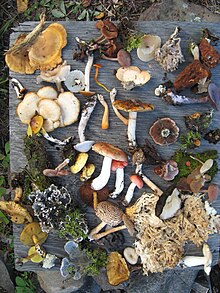
Back Biodiversiteit Afrikaans Biodiversidat AN تنوع حيوي Arabic জৈৱ বৈচিত্ৰ্য Assamese Biodiversidá AST Bioloji müxtəliflik Azerbaijani Біялагічная разнастайнасць Byelorussian Биоразнообразие Bulgarian बायोडायवर्सिटी Bihari জীববৈচিত্র্য Bengali/Bangla

Biodiversity (or biological diversity) is the variety and variability of life on Earth. It can be measured on various levels. There is for example genetic variability, species diversity, ecosystem diversity and phylogenetic diversity.[1] Diversity is not distributed evenly on Earth. It is greater in the tropics as a result of the warm climate and high primary productivity in the region near the equator. Tropical forest ecosystems cover less than one-fifth of Earth's terrestrial area and contain about 50% of the world's species.[2] There are latitudinal gradients in species diversity for both marine and terrestrial taxa.[3]
Since life began on Earth, six major mass extinctions and several minor events have led to large and sudden drops in biodiversity. The Phanerozoic aeon (the last 540 million years) marked a rapid growth in biodiversity via the Cambrian explosion. In this period, the majority of multicellular phyla first appeared. The next 400 million years included repeated, massive biodiversity losses. Those events have been classified as mass extinction events. In the Carboniferous, rainforest collapse led to a great loss of plant and animal life. The Permian–Triassic extinction event, 251 million years ago, was the worst; vertebrate recovery took 30 million years. The most recent, the Cretaceous–Paleogene extinction event, occurred 65 million years ago. This period has attracted more attention than others because it resulted in the extinction of the non-avian dinosaurs.
Human activities have lead to an ongoing biodiversity loss and an accompanying loss of genetic diversity. This process is often referred to as Holocene extinction, or sixth mass extinction. For example, it was estimated in 2007 that up to 30% of all species will be extinct by 2050.[4] Destroying habitats for farming is a key reason why biodiversity is decreasing today. Climate change also plays a role.[5][6] This can be seen for example in the effects of climate change on biomes.
- ^ Faith, Daniel P. (1992). "Conservation evaluation and phylogenetic diversity". Biological Conservation. 61 (1): 1–10. doi:10.1016/0006-3207(92)91201-3. ISSN 0006-3207.
- ^ Pillay, Rajeev; Venter, Michelle; Aragon-Osejo, Jose; González-del-Pliego, Pamela; Hansen, Andrew J; Watson, James EM; Venter, Oscar (2022). "Tropical forests are home to over half of the world's vertebrate species". Frontiers in Ecology and the Environment. 20 (1): 10–15. Bibcode:2022FrEE...20...10P. doi:10.1002/fee.2420. ISSN 1540-9295. PMC 9293027. PMID 35873358.
- ^ Hillebrand, Helmut (2004). "On the Generality of the Latitudinal Diversity graduvation". The American Naturalist. 163 (2): 192–211. doi:10.1086/381004. ISSN 0003-0147. PMID 14970922.
- ^ Cite error: The named reference
:0was invoked but never defined (see the help page). - ^ Cite error: The named reference
:1was invoked but never defined (see the help page). - ^ Cite error: The named reference
:3was invoked but never defined (see the help page).
© MMXXIII Rich X Search. We shall prevail. All rights reserved. Rich X Search